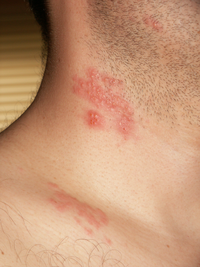
Photo from wikipedia
Periprocedural myocardial infarction (PMI) following percutaneous coronary intervention (PCI) is more frequently observed in true bifurcation lesions such as Medina (1,1,1) and (0,1,1). The aim of this study is to… Click to show full abstract
Periprocedural myocardial infarction (PMI) following percutaneous coronary intervention (PCI) is more frequently observed in true bifurcation lesions such as Medina (1,1,1) and (0,1,1). The aim of this study is to compare the incidence of PMI in elective PCI between Medina (1,1,1) and (0,1,1) bifurcation lesions. This was a retrospective, single-center study. We included 162 true bifurcation lesions, which were divided into the (1,1,1) group (n = 85) and the (0,1,1) group (n = 77). We compared the incidence of PMI between the two groups and performed multivariate logistic regression analysis using PMI as a dependent variable. The incidence of PMI was similar in the (1,1,1) group and the (0,1,1) group (12.9% versus 15.6%, P = 0.658). The final TIMI flow grade of the side branches and that of the main branches were also similar in the two groups. In multivariate logistic regression analysis, Medina classification (1,1,1) was not associated with PMI (odds ratio (OR), 0.996; 95% confidence interval (CI), 0.379-2.621; P = 0.994), but the angle of the side branch < 45° (OR, 3.569; 95% CI, 1.320-9.654; P = 0.012), lesion length in a main vessel (per 10-mm increase) (OR, 1.508; 95% CI, 1.104-2.060; P = 0.010), and absence of side branch protection (OR, 3.034; 95% CI, 1.095-8.409; P = 0.033) were significantly associated with PMI. In conclusion, the Medina (1,1,1) bifurcation lesions did not increase the incidence of PMI as compared to Medina (0,1,1). However, the narrow side branch angle, diffuse long lesion, and absence of side branch protection were significantly associated with PMI. We should pay attention to these high-risk features in the treatment of true bifurcation lesions.
Journal Title: International heart journal
Year Published: 2022
Link to full text (if available)
Share on Social Media: Sign Up to like & get
recommendations!